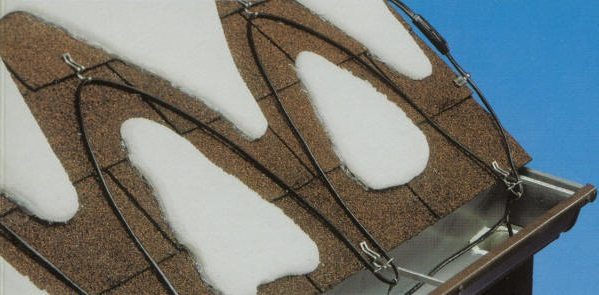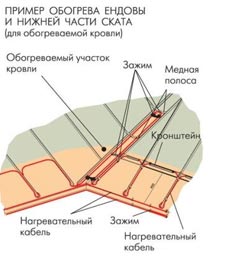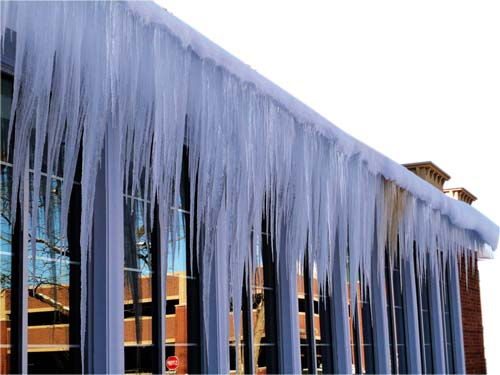In winter, almost all roofs are subject to icing - the accumulation of a large amount of ice and snow on the surface and the drainage system. This is dangerous both for passing people and for the roof itself. There is not always time and opportunity to clean the roof on time.
Therefore, anti-icing can be called the best option for keeping it in perfect condition. This is a roof heating system that will not allow ice to accumulate, it will simply melt, turning into water, and be discharged through gutters.

System design
There are several factors to consider when planning heating systems.
Things to Consider
- Climatic conditions of a particular region.
- Roof type. It can be a cold or warm roof.
- Gutter design (roofing or suspended).
- Design features of the dropper.
- The material with which the roof is covered.
- The material from which gutters and downpipes are made.
Types of thermal insulation
Roof insulation can be cold or warm type.
- A roof with good thermal insulation can be attributed to the cold type, in this case the temperature on its surface is almost the same as in the attic. With the onset of a thaw, icicles and ice form. In the case of a cold type of roof, it is enough to install the de-icer in the downpipes and along the gutters.
- The warm type includes roofs with insufficient thermal insulation, due to which heat loss from the inside of the room creates an elevated temperature on the roof surface. As a result, the accumulated snow begins to melt at the point of contact with the coating. Water flows into gutters that are colder than the roof itself, then freezes in them, forming ice. On roofs of this type, it is necessary to install an additional heating cable on the edge of the roof.
Note!
An additional cable is recommended to be laid on surfaces with a large slope angle.
It is also needed where a large layer of snow is formed.
How to choose the right type of cable
To each roofing, it is necessary to choose the best option for heating cable and its power.
Along the perimeter of the roofs, different gutters are installed, depending on the type of gutter, the type of heating is selected.
- If suspended plastic gutters are installed and the roof is of a cold type, the power of the heating system per meter of drainage is from 35 W / m to 40 W / m.
- With installed suspended metal gutters on a cold roof, the power will already be from 40 W / m to 50 W / m.
- The cold roof with rigidly installed metal gutters along the perimeter is supplied with a cable with a power of 50 W/m to 60 W/m.
Note!
The climate of the region should be taken into account, in the case of cold winters, the specific power increases by 25% of the recommended one.
To prevent ice and icicles from forming in the areas between the edge of the roof and the gutter, it is advisable to equip drip heating.
It will require a cable with a self-regulator, since heat removal is uneven along the length of the dropper. It does not matter - cold or warm type of roof in this case, so the cable can be installed in the drip in both versions.
System installation

To install the anti-icing coating, you will need fasteners. To hang the cable in the pipes of the drains, special hooks are needed, and to strengthen it on the roof, a mounting tape is needed. The cable is installed in the drain, gutters, around the roof windows and along the edges of the roof.
On rooftops with a slight slope, it is recommended to lay a resistive cable. Its advantages are in inexpensive cost, but the disadvantage is the impossibility of self-regulation of heating. Because of this, power consumption increases significantly.
It is advisable to lay a self-regulating cable along the edges and surface of the roof. In it, the heat source is a special matrix located between the current-conducting wires.
The flat cable has more surface contact, resulting in significant energy savings and reliable heating. The controller reduces heat generation when the ambient temperature rises.
When cold, the process occurs in reverse order. Thanks to this, the cable does not overheat, and the system works for a long time and reliably. Energy resources are saved and electricity costs are significantly reduced.
The regulator monitors the intensity of heating of different sections of the cable. It depends on the degree of heating of different sections of the roof. Where the sun heats the roof more, the heating of the cable is automatically reduced. In colder areas, the heating is increased by the regulator.
System Benefits

By installing a roof heating system, the owner of the house will get rid of many problems for a long time. Of course, there is a special anti-icing fluid, but it gives only a temporary effect, and it is quite troublesome to use it.
Here are the benefits that will be evident if you put an anti-icing system on your roof.
- Ice and snow will not accumulate on the roof. The safety of owners and passers-by is guaranteed in this case.
- There will be no load on the surface, this is very important especially in cases where the coating has a small margin of safety.
- Gutter systems and downspouts will not break from ice. Water, freezing, tends to expand, as a result of which the drainpipe is most likely to burst from the ice accumulated inside.
- By installing de-icers, you get rid of the laborious and not always safe work of cleaning the roof.
- Heat loss from inside the house will be minimized.This is especially important if the roof is not sufficiently insulated during installation.
- The roofing will last much longer, moisture will not destroy it, there will be no need for frequent repairs and painting.
It is clear that the advantages are obvious, and the benefits of installing an anti-icing system on the roof are great. It is recommended to take into account the installation of such systems already at the design stage of housing. This will make it easier for both the owner and those who will carry out the installation.
Did the article help you?
